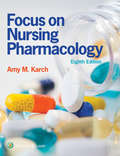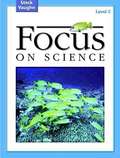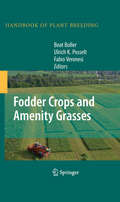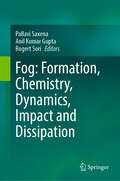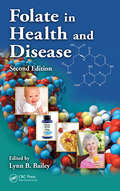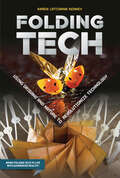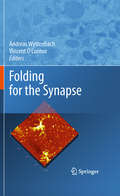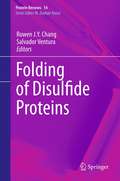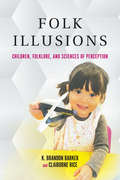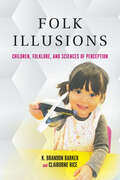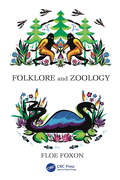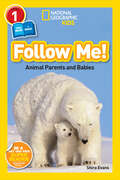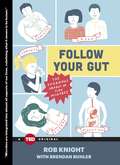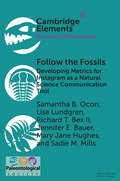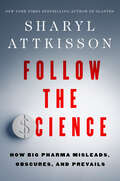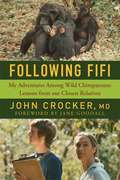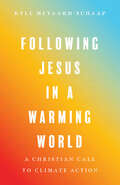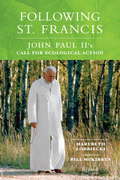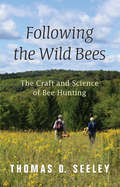- Table View
- List View
Focus on Life Science (California Edition, Grade #7)
by Donald FisherLearn more about the science of living things in this interesting textbook.
Focus on Nursing Pharmacology (Coursepoint+)
by Amy M. KarchMaster the Principles of Effective Drug Therapy Current, concise, and optimized for today’s nursing practice, Focus on Nursing Pharmacology makes challenging concepts more approachable to establish a foundation for effective drug therapy throughout your nursing career. This updated 8th edition builds on your knowledge of physiology, chemistry and nursing fundamentals to help you conceptualize need-to-know information about each group of drugs, while engaging learning features cultivate your clinical application, critical thinking and patient education capabilities. NEW! Concept Mastery Alerts alert you to commonly misunderstood concepts. NEW! Unfolding case-based vignettes written by the National League for Nursing bring concepts to life through realistic clinical scenarios. Concise, streamlined approach emphasizes need-to-know information for efficient learning. Nursing Processes clarify the process for planning patient-centered care. Critical Thinking Scenarios guide you through the collection and application of data for commonly encountered clinical interactions. Nursing Considerations sections detail the rationale behind each nursing intervention to enhance your clinical decision-making capabilities. Drug Lists at the beginning of each chapter enable fast identification of prototype drugs for each class. Drugs in Focus tables provide at-a-glance reference for generic and trade names, usual dosage and indications for each drug within a class. Focus on Safe Medication Administration boxes help you ensure patient safety and increase the therapeutic effectiveness of drugs. Focus on the Evidence boxes identify the best nursing practices associated with specific drugs based on available evidence. Focus on Herbal and Alternative Therapies alert you to known interactions with specific herbs or alternative therapies that could affect drug actions. Focus on Calculations refine your calculation and measurement skills. Focus on Drug Therapy Across the Lifespan boxes provide quick access to drug class considerations for use with children, adults and the elderly. Focus on Gender Considerations and Focus on Cultural Considerations help you ensure effective, culturally sensitive drug therapy across diverse populations. Check Your Understanding sections equip you for your exams with NCLEX®-style review questions, including alternate-format questions. Watch and Learn videos available on thePoint® help you avoid medication errors in practice.
Focus on Physical Science
by Jack Price Charles H. HeimlerFocus on Physical Science is a practical study of the relationship between matter and energy. Fundamental Physical Science principles are introduced through student involvement rather than by rote memorization. This book comprises seven units, the contents of which include Measurement and Motion, Classification of Matter, Patterns in Matter, Changes in Matter, Light and Sound, Energy, Energy Resources for the Future. Units of Measurement and Laboratory Techniques form part of Appendix.
Focus on Physical Science (California Edition)
by T. Griffith Jones David V. Frank John G. Little et. alEvery chapter begins with a Focus on the Big Idea question that is linked to a California Science Standard. It also promotes active reading and enhances student note taking skills, and gives teachers a useful tool in guiding the students to study and learn. Each chapter is organized into nine general standard sets which are Motion, Forces, Structure of Matter, Earth in the Solar System, Reactions, Chemistry of Living Systems, Periodic Table, Density and Buoyancy, and Investigation and Experimentation.
Focus on Science, Level C
by Steck-VaughnJust like you, these animals have grow a lot. At one time, they were too small to see! These animals are still growing. In time, they will be as big as their mother. Then, they will be able to have babies of their own. In this unit you will learn how living things grow and change during their lives. You will also learn how to keep healthy as your own body grows and changes.
Focused Ion Beam Systems
by Nan YaoThe focused ion beam (FIB) system is an important tool for understanding and manipulating the structure of materials at the nanoscale. Combining this system with an electron beam creates a DualBeam - a single system that can function as an imaging, analytical and sample modification tool. Presenting the principles, capabilities, challenges and applications of the FIB technique, this edited volume comprehensively covers the ion beam technology including the DualBeam. The basic principles of ion beam and two-beam systems, their interaction with materials, etching and deposition are all covered, as well as in situ materials characterization, sample preparation, three-dimensional reconstruction and applications in biomaterials and nanotechnology. With nanostructured materials becoming increasingly important in micromechanical, electronic and magnetic devices, this self-contained review of the range of ion beam methods, their advantages, and when best to implement them is a valuable resource for researchers in materials science, electrical engineering and nanotechnology.
Fodder Crops and Amenity Grasses
by Fabio Veronesi Ulrich K. Posselt Beat BollerThe main role of grasses, clovers and alfalfa in temperate agriculture is still to provide forage for ruminant animals but, in the last decades, the importance of amenity grasses increased markedly and, in the near future, new developments in the areas of energy and biomass use can be envisaged. Fodder Crops and Amenity Grasses, fifth volume in the series, Handbook of Plant Breeding, covers all these aspects. Most fodder crops and amenity grasses are perennials and many of them are natural or induced polyploids. Thus, breeding procedures and strategies differ greatly from breeding annual field crops. Breeding objectives are more difficult to define in forage crops because direct measurement of the efficiency of animal production during breeding and variety assessment is impractical. As a result, a large number of selection criteria have been developed for the particular crops. However, breeding objectives and methodology have a common basis among these species and are therefore presented in the general chapters. Particular emphasis is placed on the breeding methodology for cross-pollinating species because the large majority of crops belong to this group. In addition, the potential of new molecular techniques to complement breeding concepts and strategies is presented and critically discussed. Special techniques and procedures as well as particular breeding goals will be included in the crop specific chapters. Amenity grass breeding has its own breeding objectives and testing procedures, however, the species are mostly the same as in forage grass breeding, and crop specific chapters will include the amenity aspects where appropriate. The crop specific chapters will cover the range of topics given in the guidelines below. The volume on Fodder Crops and Amenity Grasses is the fifth volume in series Handbook of Plant Breeding after the initial volumes on Vegetables, Cereals, Oil Crops and Fruits. Like the other volumes in the series, the volume presents information on the latest scientific information in applied plant breeding using the current advances in the field, from efficient use of genetic resources to impact of biotechnology in plant breeding. Outstanding scientists from all over the world have contributed chapters to the work.
Fog: Formation, Chemistry, Dynamics, Impact and Dissipation
by Anil Kumar Gupta Pallavi Saxena Rogert SoríThis book addresses the atmospheric phenomenon of fog formation and its impacts on plant and human life. It covers the chemistry, formation, dynamics, impacts and dissipation of the fog. It also elucidate basic concepts of formation of fog, role of meteorology in fog formation, chemistry of fog, how different chemical constituents present in fog affects its quality and surrounding atmosphere, impacts on plant species, human health, visibility and economy and dissipation of fog by cost effective techniques. It also highlights the use of some plant species in managing the fog induced pollution. This book is of interest to teachers, researchers, climate change scientists, professionals involved in air quality, meteorology, plant and humans related research, capacity builders and policymakers. Also the book serves as additional reading material for undergraduate and graduate students of agriculture, forestry, ecology, and environmental sciences. National and international environmentalists, policy makers will also find this to be a useful read.
Folate in Health and Disease
by Lynn B. BaileyDuring the fifteen years since the bestselling first edition of Folate in Health and Disease was published, there have been thousands of new research studies related to folate and its role in health and disease. The second edition of the book uniquely bridges the gap between basic science and public health/clinical medicine.Presents Groundbreaking
Folding Tech: Using Origami and Nature to Revolutionize Technology
by Karen Latchana KenneySpace probes, self-assembling robots, crash-absorbing cars, and designer proteins all have one thing in common: their use of folding technologies. To develop these technologies, engineers are taking inspiration from an unusual source—origami, the ancient art of paper folding. Examine origami's origins, how it intersects with mathematics, and how it became a tool to solve some of the most complicated challenges in engineering, architecture, technology, and medicine today. Plus, get a close-up look at these technologies with two augmented reality images included in the book!
Folding for the Synapse
by Andreas Wyttenbach Vincent O'ConnorFolding for the Synapse addresses the current view on how protein folding and misfolding, controlled by molecular chaperones, contribute to synapse function and dysfunction. Molecular chaperones have been studied in relation to de novo protein folding, but there is increasing awareness that chaperone function is required for the regulation of protein dynamics when functioning physiologically as an isolated moiety or part of a protein complex. This book will introduce both important concepts of folding machineries and give examples of the biological relevance of further chaperone functions.
Folding of Disulfide Proteins
by Rowen J. Chang Salvador VenturaThis book aims to cover the knowledge of protein folding accumulated from studies of disulfide-containing proteins, including methodologies, folding pathways, and folding mechanism of numerous extensively characterized disulfide proteins. Folding of Disulfide Proteins will be valuable supplementary reading for general biochemistry, biophysics, molecular biology, and cellular biology courses for graduate and undergraduate students. This book can also be used for specialized graduate-level biochemistry, biophysics, and molecular biology courses dedicated to protein folding as well as related biological problems and diseases. Will also be of interest to everybody interested in problems related to protein folding, and anyone who is interested in understanding the mechanism of protein misfolding and protein misfolding-related diseases.
Folk Illusions: Children, Folklore, and Sciences of Perception
by K. Brandon Barker Claiborne RiceWiggling a pencil so that it looks like it is made of rubber, "stealing" your niece's nose, and listening for the sounds of the ocean in a conch shell– these are examples of folk illusions, youthful play forms that trade on perceptual oddities. In this groundbreaking study, K. Brandon Barker and Clairborne Rice argue that these easily overlooked instances of children's folklore offer an important avenue for studying perception and cognition in the contexts of social and embodied development. Folk illusions are traditionalized verbal and/or physical actions that are performed with the intention of creating a phantasm for one or more participants. Using a cross-disciplinary approach that combines the ethnographic methods of folklore with the empirical data of neuroscience, cognitive science, and psychology, Barker and Rice catalogue over eighty discrete folk illusions while exploring the complexities of embodied perception. Taken together as a genre of folklore, folk illusions show that people, starting from a young age, possess an awareness of the illusory tendencies of perceptual processes as well as an awareness that the distinctions between illusion and reality are always communally formed.
Folk Illusions: Children, Folklore, and Sciences of Perception
by K. Brandon Barker Claiborne Rice“[A] well-researched and well-written book . . . linking traditional folklore studies to current scientific research and to thinking about human behavior.” —American Journal of PlayWiggling a pencil so that it looks like it is made of rubber, “stealing” your niece’s nose, and listening for the sounds of the ocean in a conch shell—these are examples of folk illusions, youthful play forms that trade on perceptual oddities. In this groundbreaking study, K. Brandon Barker and Claiborne Rice argue that these easily overlooked instances of children’s folklore offer an important avenue for studying perception and cognition in the contexts of social and embodied development. Folk illusions are traditionalized verbal and/or physical actions that are performed with the intention of creating a phantasm for one or more participants. Using a cross-disciplinary approach that combines the ethnographic methods of folklore with the empirical data of neuroscience, cognitive science, and psychology, Barker and Rice catalogue over eighty discrete folk illusions while exploring the complexities of embodied perception. Taken together as a genre of folklore, folk illusions show that people, starting from a young age, possess an awareness of the illusory tendencies of perceptual processes as well as an awareness that the distinctions between illusion and reality are always communally formed.“With clear focal points, sound and carefully explained methodology, and thought-provoking, substantial analysis, this book makes an excellent contribution to children’s folklore and related fields.” —Elizabeth Tucker, author of Children’s Folklore: A Handbook“A compendium of perceptual illusions, gathered from performers across the country, sorted into formally related perceptual categories, and analyzed under various theories of perception.” —Journal of Folklore Research
Folklore and Zoology
by Floe FoxonA scientific excursion into folklore, zoology, and cryptozoology, this text highlights a field, often called a pseudoscience, which seriously considers the possible existence of hidden or unknown animals not recognised in conventional zoology. Folklore and Zoology accessibly reviews the science of DNA samples; film and photograph analysis; hair and footprint examination; and the statistics behind such alleged animals as Sasquatch and the Yeti, Nessie and Champ, the Griffin and the Thunderbirds, and the possible survival of the thylacine, ivory-billed woodpecker, eastern cougar, and others. With over 400 references, Folklore and Zoology is among the most complete scientific review of cryptozoology to date, with discussion of the history and future, and successes and failures of this controversial and fascinating field, offering a fresh synthesis of a highly interdisciplinary literature. This book is ideal reading for students and academics interested in and studying zoology, palaeontology, and folklore courses.
Folklore of American Weather
by Eric SloaneIn preparing this unusual book of American weather sayings and beliefs, Eric Sloane has made a painstaking effort to separate the true from the false, investigating origins and separating the many truly valuable pieces of weather lore from superstition, or what he calls "jackass jingles." As Mr. Sloane makes clear, folklore can be a very loose term used to cover a lack of knowledge of the very thing that folklore means: many things are passed off as folklore that are plain mistakes or inventions. Following general introductory remarks, Mr. Sloane has arranged his findings in an alphabetical folklore dictionary, enabling the reader to find readily the signs involving stars, wind, dew, rain, or whatever else he wishes. After each entry is a symbol indicating whether it is true (T), false (F), or possible (P). Thirty-five drawings by the author clarify and enhance the text of this entertaining and informative new book by America's favorite weather expert.
Follow Me!: Animal Parents and Babies (Readers)
by Shira EvansJoin animal moms, dads, and babies, as these animal parents teach their young ones about the world. Adult and child readers can cuddle up and read aloud and learn together in this new "you read, I read" co-reader format.
Follow Your Gut: The Enormous Impact of Tiny Microbes (TED Books #4)
by Rob Knight Brendan BuhlerAllergies, asthma, obesity, acne: these are just a few of the conditions that may be caused--and someday cured--by the microscopic life inside us. The key is to understand how this groundbreaking science influences your health, mood, and more.In just the last few years, scientists have shown how the microscopic life within our bodies-- particularly within our intestines--has an astonishing impact on our lives. Your health, mood, sleep patterns, eating preferences--even your likelihood of getting bitten by mosquitoes--can be traced in part to the tiny creatures that live on and inside of us. In Follow Your Gut, pioneering scientist Rob Knight pairs with award-winning science journalist Brendan Buhler to explain--with good humor and easy-to-grasp examples--why these new findings matter to everyone. They lead a detailed tour of the previously unseen world inside our bodies, calling out the diseases and conditions believed to be most directly impacted by them. With a practical eye toward deeper knowledge and better decisions, they also explore the known effects of antibiotics, probiotics, diet choice and even birth method on our children's lifelong health. Ultimately, this pioneering book explains how to learn about your own microbiome and take steps toward understanding and improving your health, using the latest research as a guide.
Follow the Fossils Follow the Fossils: Developing Metrics for Instagram as a Natural Science Communication Tool (Elements of Paleontology)
by Jennifer E. Bauer Samantha B. Ocon Lisa Lundgren Richard T. Bex II Mary Jane Hughes Sadie M. MillsThe ability for people to connect, learn, and communicate about science has been enhanced through the Internet, specifically through social media platforms. Facebook and Twitter are well-studied, while Instagram is understudied. This Element provides insight into using Instagram as a science education platform by pioneering a set of calculated metrics, using a paleontology-focused account as a case study. Framed by the theory of affinity spaces, the authors conducted year-long analyses of 455 posts and 139 stories that were created as part of an informal science learning project. They found that team activity updates and posts outside of their other categories perform better than their defined categories. For Instagram stories, the data show that fewer slides per story hold viewers' attention longer, and stories using the poll tool garnered the most interaction. This Element provides a baseline to assess the success of Instagram content for science communicators and natural science institutions.
Follow the Science: How Big Pharma Misleads, Obscures, and Prevails
by Sharyl AttkissonEmmy Award-winning investigative journalist and New York Times bestselling author Sharyl Attkisson exposes the corruption that has ruled the pharmaceutical industry for decades.Through blatant lies, deep cover-ups, and high-level collusion with government and media, Big Pharma has continuously put profits over people with dangerous results. Now, with her signature investigative rigor and uncompromising commitment to the facts, Sharyl Attkisson takes readers on an shocking journey through the dark underbelly of the pharmaceutical industry.Follow the Science recounts, in exacting detail, how far the pharmaceutical industry and its supporters in medicine, media, and government will go to protect their profits. Attkisson provides shocking examples that reveal the disturbing callousness our government, public health officials, and top researchers are capable of when it comes to the most vulnerable among us. And she explains, in a graphic sense, how some of the most trusted within our society are willing to commit life-threatening ethics violations. When caught, they circle the wagons and marshal forces to defend their bad acts and take steps to cruelly silence the injured and smear those who would expose them.This book includes exclusive, eye-opening evidence including:Financial ties between well-known vaccine promoters and the vaccine industryOutrageous collusion between the news media and Big PharmaHow Big Pharma teaches slanted information to med students and doctorsGovernment officials secretly admitting vaccines caused some cases of autismThe first child seriously injured by Covid vaccines while in Pfizer's studyThe secretive money backing seemingly independent studies and nonprofitsFollow the Science will challenge your assumptions, open your eyes, and inspire you to take action. With its powerful message of truth and justice, this book is a must-read for anyone who cares about the future of our healthcare system and their own family's health.
Following Fifi: My Adventures Among Wild Chimpanzees: Lessons From Our Closest Relatives
by Jane Goodall John CrockerAn exhilarating quest into a remote African forest to examine chimpanzees and understand the roots of human behavior. As a young student, John Crocker embarked on the adventure of a lifetime, spending eight months in the Gombe forest working with Jane Goodall. He followed families of wild chimpanzees from sunrise to sunset and learned the fundamental behavioral traits of these chimps as they raised their offspring. One chimpanzee captivated him. Her name was Fifi, and she displayed extraordinary patience and reassurance toward her infant, Freud. Upon returning home and becoming a doctor, Crocker found himself incorporating the lessons he learned from Fifi into his work as a father and physician. When he witnessed his young patients rocketing around his exam room, he would picture Fifi’s patience and tacit approval of Freud’s uninhibited and joyful exploration. Crocker shares how his time spent with our closest animal cousins has helped him better understand his patients with ADD, anxiety, and depression, and how primate traits hardwired into our own natural behavior help chimpanzees protect their community, raise their young, and survive. Finally, chronicling his return to Gombe thirty-six years later with his own son, he reflects on how his experience with the chimps has come full circle. An illuminating book that will raise thought-provoking questions about the evolution of human behavior and the importance of patience and strong family bonds, Following Fifi provides a greater understanding of what it means to be human.
Following Jesus in a Warming World: A Christian Call to Climate Action
by Kyle Meyaard-SchaapHave you ever looked at the effects of climate change and the apathy of so many around you and wondered, "What are we missing here?" Climate activist Kyle Meyaard-Schaap understands this feeling from personal experience. But in his years of speaking to and equipping Christians to work for climate action, he's seen the trend begin to shift. More and more young Christians are waking up to the realities of climate change. They want to help, but they're not sure how. Through stories from the field, theological and scriptural exploration, and practical advice, Meyaard-Schaap offers hope to Christians paralyzed by the scale of the crisis, helping us turn our paralysis into meaningful action. Following Jesus in a Warming World is a field guide for Christian climate action—one grounded not in a sense of guilt or drudgery, but in the joy of caring for creation.
Following St. Francis
by Marybeth Lorbiecki Bill MckibbenThe first book to present the environmental teachings of this beloved pope--the newly canonized St. John Paul--and the hopeful words of Pope Francis, thoughtfully synthesized into a complete spiritual and practical vision for the future. "The ecological crisis is a moral crisis." So said Pope John Paul II, an unexpected and fierce advocate for ecological responsibility throughout his papacy. Rather than seeing environmental concerns as "earthly" or "political," he showed that they are in fact at the heart of the covenant between human beings and their Creator. In dozens of addresses, sermons, and encyclicals, Pope John Paul II made specific recommendations on twelve interconnected ecological issues, including climate change, ocean destruction, water scarcity, poverty, the role of women, and war. He showed that each could become a source of spiritual, social, and economic transformation.Following St. Francis integrates Pope John Paul II's vision with that of St. Francis of Assisi, patron saint of ecology, and the galvanizing words of Pope Francis. Accessible and illuminating, it speaks to hearts and minds, to nonreligious readers as well as devoted Catholics, incorporating Scripture, current science, and inspiring stories of solutions and restoration. Marybeth Lorbiecki unifies and champions the late, beloved pope's view that all life issues are related and that all forms of life deserve care. And if we work with God and each other to protect them, we can "renew the face of the earth" (Psalm 104:30).From the Hardcover edition.
Following the Wild Bees: The Craft and Science of Bee Hunting
by Thomas D. SeeleyFollowing the Wild Bees is a delightful foray into the pastime of bee hunting, an exhilarating outdoor activity that used to be practiced widely but which few people know about today. Thomas Seeley, a world authority on honey bees, vividly describes the history and science behind this lost pastime and how anyone can do it. Following the Wild Bees is both a unique meditation on the pleasures of the natural world and a guide to the ingenious methods that compose the craft of the bee hunter.Seeley explains how one finds a patch of flowers humming with honey bees, captures and sumptuously feeds the bees, and then releases and follows them, step-by-step in whatever direction they fly, back to their secret residence in a hollow tree, old building, or abandoned hive. The bee hunter's reward is a thrilling encounter with nature that challenges mind and body while also giving new insights into the remarkable behavior of honey bees living in the wild.Drawing on decades of experience as a bee hunter and bee biologist, Seeley weaves informative discussions of the biology of wild honey bees with colorful historical anecdotes, personal insights, and beautiful photos. Whether you're a bee enthusiast or just curious about the natural world, Following the Wild Bees is the ideal companion for newcomers to bee hunting and a rare treat for armchair naturalists.

